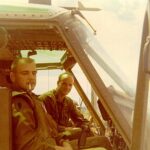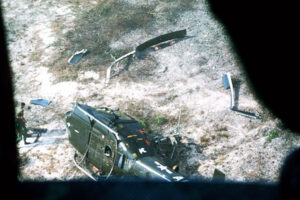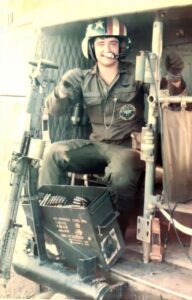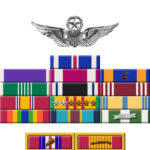In the Summer of 1969, the 14th Combat Aviation Battalion (CAB) Commanders made devastating decisions costing the lives of many aviation soldiers under their command. These ‘leftover lieutenants’ from the 1950s RIF were now our commanders.
One of those decisions was to allow only ‘commissioned’ officers to act as flight leaders or aircraft commanders for both the armed platoon and the slick (troop/resupply) platoons. Before this foolish decision, the most experienced pilots were the fire team leaders and formation flight leaders in the 14th CAB assault helicopter units. Irrespective of ‘rank’, previously the most experienced pilot(s) were charged with leading combat assaults, armed fire support missions, etc.
Commissioned officers were affectionately referred to as Real Live Officers (RLOs) and were both/either new ‘in-country’ or severely inexperienced in the day-to-day demands of combat flying. The RLOs were platoon leaders, staffers, or other company level officers – and not current with the grueling requirements of daily combat missions in the area of operations.
The assistant supply officer (ASO) sequestered himself for months in the supply room. Never seen anywhere else, not the Club nor the mess hall. Lived alone and ‘worked’ alone, and never flew regular missions. The air-conditioned office was a lot cooler than the cockpit of a Huey helicopter.

After the previous day’s losses of two slick crews, the ASO was called out and assigned to ride shotgun (co-pilot) on a much-needed resupply mission into the battle zone that previously claimed Rattler 19 and Rattler 26 aircrews.
The mission was successful, resupply completed and the ASO returned to his supply room desk. 45 years later he was awarded the Distinguished Flying Cross for that same mission!
Being in the Company headquarters is always politically advantageous – the company clerk writes up the award, the C.O. approves it and viola,` a war hero is created from the admiring administrators. Rank has its privileges.
Another superlative ‘rank pulling’ event was MG Getty’s decision to order his pilot to overfly his C&C helicopter’s fuel range. MG Gettys was the AMERICAL Division commander when in November 1968, his aircraft crashed into jungle terrain north of Chu Lai. Late for a meeting and despite warnings that the helicopter was low on fuel, MG Gettys ordered his pilots to continue. Sure enough the Huey ran out of fuel. The General was late for his meeting.

The CG was injured in the crash and unable to move, was rescued/removed from the downed and damaged helicopter by a passenger – Major Colin Powell. Major Powell ‘along for the ride’ would later become Chairman of the U.S. Joint Chiefs of Staff. Because of bad weather, the group remained overnight at the jungle crash site before rescue the following day. Major Powell received the Soldier’s Medal for his rescue of MG Gettys. Another ‘ribbon for the rack.’ RHIP!
The most disastrous effect of this local ‘RLO only’ policy occurred when an overzealous officer ordered his flight of three Huey gunships to fly into severe weather conditions for no other purpose than to return early to base camp. His decision would take his life and the other three members of his helicopter crew. The entire four man crew would be MIA for over 40 years.
When one pilot refused to launch he was threatened with court martial. Thankfully the other two aircraft and crews returned safely to home base.
Had I been on that mission not only would I have refused to fly; I would have recommended a flight evaluation board action against the pilot/officer for not only using poor judgement but also endangering the lives of 11 crewmen, not to mention the potential loss of three helicopter gunships.
These battalion and company level ‘commanders’ were formerly trained in infantry, artillery, etc. specialties and not in aviation. Some also thought they were structural aircraft design engineers leading to another ridiculous decision requiring the helicopter gunship pilot doors to remain on the aircraft. Previously the doors were removed allowing better visibility during attack operations. If caught flying with doors off subjected the pilot-in-command to disciplinary actions.
The commander’s rationale was the doors were a structural component that in fact proved untrue according to Bell Helicopter. Closed & locked doors also prevented rapid evacuation and possible entrapment in the event of a crash. My crash & splash proved correct – when we hit the water filled rice paddy, I elbowed my side-seat armor plate rearward and rolled out the open door.
Note to the Company Commander – the helicopter cargo doors where always flown open in-flight – maybe you never noticed.

But the most bizarre thing ever was the command directive that no crewmembers should wear a white flight helmet (although previously Army issued). The commanders thought the white helmet would be a gigantic aiming point for the bad guy ground gunners. Uh huh, who thought up this one? This large green machine churning through the air overhead is a HUGE target – and some gook gunner is gonna’ aim at a white helmet?
Another fun happening was the battalion size combat assaults (CA). These CAs would consist of a huge formation of at least two units of slicks (18), several gunship teams, low level ‘smoke’ ships, and high above, the Battalion Commander in his command helicopter. To prove their mettle, the Company Commanders would fly in the formation lead aircraft (with a very seasoned co-pilot to keep them out of trouble). Combat Colonels we can do without.
Aircraft zigzagging through the air, with the smoke ship laying a white oily cloud along the landing zone perimeter, and the trailing gunships firing red tracer streams through the smoke cloud, the slicks would land and deposit the grunts. Cecille B. Demille could not have planned a more spectacular experience! All manner of radio chatter would be exchanged between these part-time peter pilots, the colonel commanders congratulating each other on a ‘good show’, the company commanding officers enjoying the glow of glorious comments.

Returning to their staff offices, the clerks would ‘write them up’ recounting their valor and courage that day. Fliers kept flying, staffers kept staffing, killers kept killing. All is well again in the war.
(c) Copyright – 2023 Vic Bandini